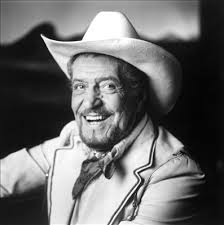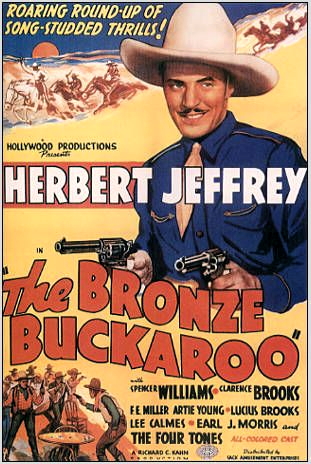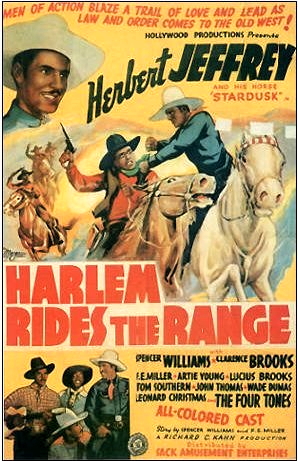
Jazz singer and actor Herb Jeffries, the first black singing cowboy to grace Hollywood screens, died of heart failure in West Hills, California, on May 25, 2014. He was about 100.
In 2008, mystery writer Gary Phillips contributed this thoughtful essay about Jeffries to Mystery Scene.
Tempest Storm is 80 and still stripping. Indeed, this past June at the Palms Hotel and Casino in Las Vegas she did the bump and grind, and didn’t dislocate her hip, at the annual All-Star Burlesque Weekend. Her hair is dyed a brilliant orange to match her neon orange nails. “I just don’t get up there and rip my clothes off,” the G-string queen noted. Her contemporaries Blaze Starr and Lili St. Cyr may have been discarded to the broken pole dustbin of stripper history, but not Ms. Storm. She kept performing in Vegas, Reno, Palm Springs, Miami, and even at Carnegie Hall. Imagine Death at the Bob Hope Memorial Retirement Home in Palm Springs as Ms. Storm does her thing and sends some of the old boys—and a few women probably—into apoplectic shock.
But what the heck, you ask, does the “Girl with that Fabulous Front,” who once had those assets insured by Lloyds of London, have to do with the mystery field? Well, wonder no more, for in 1967 Ms. Storm, playing Miss Tango, the owner of the Temple of Beauty Health Club, starred in Mundo Depravados or the World of the Depraved—though apparently also known as Meet Me Under the Bed in its initial release. The plot of this comedic puzzler, as it were, concerns some dude in a trench coat going around attacking the female members of this spa and two inept cops who show up to solve the mess. Alas, Tempest bares nothing in this effort, save her acting talent, while the younger women in this epic bare some skin.
 Insignificant, you’d say. Well, yes, except there is a subgenre of mystery and crime films that miss the mark wide, shall we say, that are worth viewing in a Mystery Science Theater 3000 kind of way. Actually, Mickey Spillane is in two of these bad boys. In Ring of Fear, he gets second billing to Clyde Beatty as he plays himself called in by Pat O’Brien, the owner of the Clyde Beatty Circus, to investigate some shady doings at the circus. Then there’s The Girl Hunters, wherein Mickey plays his own famous PI creation, Mike Hammer. Girl Hunters does have a pretty good fight scene in a barn with the hero’s nemesis, The Dragon. The Two Jakes, the sequel to the near-flawless Chinatown belongs in this mish-mosh of Mondo Weird works, as well as the horrid butchery of the V.I. Warshawski movie starring Kathleen Turner.
Insignificant, you’d say. Well, yes, except there is a subgenre of mystery and crime films that miss the mark wide, shall we say, that are worth viewing in a Mystery Science Theater 3000 kind of way. Actually, Mickey Spillane is in two of these bad boys. In Ring of Fear, he gets second billing to Clyde Beatty as he plays himself called in by Pat O’Brien, the owner of the Clyde Beatty Circus, to investigate some shady doings at the circus. Then there’s The Girl Hunters, wherein Mickey plays his own famous PI creation, Mike Hammer. Girl Hunters does have a pretty good fight scene in a barn with the hero’s nemesis, The Dragon. The Two Jakes, the sequel to the near-flawless Chinatown belongs in this mish-mosh of Mondo Weird works, as well as the horrid butchery of the V.I. Warshawski movie starring Kathleen Turner.
But back to Tempest and her film, which had something going for it behind the scenes, a real hook, the twist you seek to read or write in the crafting of the mystery. The film was written (and that might be a kind word here) and directed by Tempest’s then-husband, singer and actor Herb Jeffries. They divorced three years after the movie came out—draw your own conclusions.
Yet for some years I knew that Herb Jeffries, before he had diverse small roles on Hawaii 5-0, had starred in four low budget cowboy flicks in the late ’30s that earned him the moniker the Bronze Buckaroo. For these were films with black casts aimed at black audiences. Later Jeffries, a commanding baritone, would be a crooner with the Duke Ellington and Earl “Fatha” Himes bands. The thing is, Herb is not black, not one bit. Because of the movies and his association with the aforementioned bands, he was naturally thought to be part black. Jeffries himself at times claimed to be Creole.
But as he recounts in the recent documentary A Colored Life: The Herb Jeffries Story—which I saw at the Pan African Film Festival this year—the Detroit’s native’s biological father was Sicilian and his mother Irish-Canadian. After Umberto Alesandro Valentino’s father died in WWI, his Irish-Canadian mother remarried an Ethiopian immigrant named Jeffries.
Herb, like Johnny Otis, became a voluntary black man, willingly stripping himself of his identity to, ironically considering the times, advance his career. Really, Johnny never pretended to be black per se but dropped in and never left. Herb at some point in the ’50s just as easily slipped back across the color line to “become” white again. But until I saw that doc, I always assumed he was part black.

 This racial crossing/obfuscating is another subgenre, a theme used in several mystery books and films. Devil in a Blue Dress comes to mind as does the little seen but intriguing picture Slow Burn. So as the octogenarian sex bomb Tempest Storm slowly and artfully removes her garments under the glare of the lights, I can’t help but reflect how her ex-husband, once upon a time, fandangled with the garments of race while the music played.
This racial crossing/obfuscating is another subgenre, a theme used in several mystery books and films. Devil in a Blue Dress comes to mind as does the little seen but intriguing picture Slow Burn. So as the octogenarian sex bomb Tempest Storm slowly and artfully removes her garments under the glare of the lights, I can’t help but reflect how her ex-husband, once upon a time, fandangled with the garments of race while the music played.
Gary Phillips is a well-known crime novelist and essayist.
This article first appeared in Mystery Scene Fall Issue #106.


